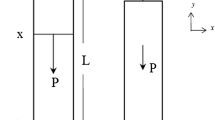Abstract
A new method called the interval factor method for the finite element analysis of truss structures with interval parameters is presented in this paper. The structural parameters and applied forces can be considered as interval variables by using the interval factor method, the structural stiffness matrix can then be divided into the product of two parts corresponding to the interval factors and the deterministic value. From the static governing equations of interval finite element method of structures, the structural displacement and stress responses are expressed as the functions of the interval factors. The computational expressions for lower and upper bounds, mean value and interval change ratio of structural static responses are derived by means of the interval operations. The effect of the uncertainty of the structural parameters and applied forces on the structural displacement and stress responses is demonstrated by truss structures.
Similar content being viewed by others
References
Alefeld G, Herzberber J (1983) Introductions to interval computations. Academic, New York
Chen SH, Yang XW (2000) Interval finite element method for beam structures. Finite Elem Anal Des 34:75–88
Chen SH, Lian HD, Yang XW (2003) Interval eigenvalue analysis for structures with interval parameters. Finite Elem Anal Des 39:419–431
Chen SH, Guo KJ, Chen YD (2004) A method for estimating upper and lower bounds of eigenvalues of closed-loop systems with uncertain parameters. J Sound Vib 276:527–539
Cho KN (2002) Mass perturbation influence method for dynamic analysis of offshore structures. Struct Eng Mech 13:429–436
Gao W, Chen JJ, Ma J, Liang ZT (2004) Dynamic response analysis of stochastic frame structures under non-stationary random excitation. AIAA Journal 42:1818–1822
Gao W, Chen JJ, Cui MT, Cheng Y (2005) Dynamic response analysis of linear stochastic truss structures under stationary random excitation. J Sound Vib 281:311–321
Hansen E (1992) Global optimization using interval analysis. Marcel Dekker, New York
Hudak D (1984) Ein Eigenwertproblem Fur Intervall-Matrizen. J Appl Math Mech 64:503–505
Moens D, Vandepitte D (2005) A survey of non-probabilistic uncertainty treatment in finite element analysis. Comput Methods Appl Mech Eng 194:1527–1555
Moore RE (1979) Methods and applications of interval analysis. Prentice-Hall, London
Qiu ZP, Wang XJ (2005) Parameter perturbation method for dynamic responses of structures with uncertain-but-bounded parameters based on interval analysis. Int J Solids Struct 42:4958–4970
Rohn J (1987) Eigenvalues of a symmetric interval matrix. Freiburger Intervall-Berichte 87:67–72
Soize C (2003) Random matrix theory and non-parametric model of random uncertainties in vibration analysis. J Sound Vib 263: 893–916
Author information
Authors and Affiliations
Corresponding author
Rights and permissions
About this article
Cite this article
Gao, W. Interval Finite Element Analysis using Interval Factor Method. Comput Mech 39, 709–717 (2007). https://doi.org/10.1007/s00466-006-0055-8
Received:
Accepted:
Published:
Issue Date:
DOI: https://doi.org/10.1007/s00466-006-0055-8




